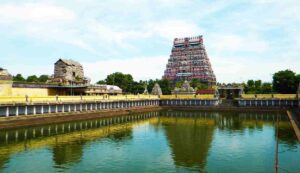Nataraja Temple: The amazing story and mystery of Lord Shiva’s dance
Nataraja Temple: Dedicated to Lord Shiva in the shape of the cosmic dancer Nataraja, the Nataraja Temple is also called the Chidambaram Temple. One of the oldest and most significant Shiva temples in India, it is situated in the Tamil Nadu town of Chidambaram and is well-known for both its deep spiritual importance and its distinctive depiction of the god.

Historical Importance
The Nataraja Temple has more than a thousand years of history. The temple has been a hub of religious and cultural activity for centuries, and its roots are in the Tamil Shaivite tradition. Although the location has been a destination of devotion since ancient times, the Chola dynasty (9th to 13th century) is said to have constructed the temple in its current shape.
The temple was enlarged and improved by the Cholas, who were excellent patrons of the arts and architecture, turning it into a masterpiece of Dravidian design. A number of Tamil literary works also make reference to the temple, underscoring its significance in the area’s religious and cultural past.
The Nataraja Temple’s Appearance
The Nataraja Temple is a 50-acre architectural wonder including four enormous gopurams (gateways) with elaborate sculptures of Hindu gods and mythical figures. The main shrine in the temple complex is devoted to Lord Nataraja, and there are other shrines, halls, and mandapams (pillared halls) as well.
The deity of Nataraja is placed in the sanctum sanctorum, also known as the Hall of Consciousness or the Chit Sabha. Lord Shiva is seen in the Nataraja figure executing the Ananda Tandava, or dance of happiness, which represents the cosmic cycles of creation, preservation, and destruction. Shiva in this form is shown as an elegant dancer who is crushing the demon Apasmara, which stands for ignorance, with one leg lifted.
The “Chidambara Rahasya,” an empty area behind the statue of Nataraja, is another distinctive element of this temple. It represents the idea of formlessness and the notion that God is beyond human comprehension.
Religious Importance
One of the Pancha Bhoota Sthalams, the Nataraja temple symbolizes the element of space, sometimes known as the sky or ether. The temple’s importance as a hub for spiritual learning and achievement is further shown by its association with the idea of Chidambaram, which translates to “atmosphere of wisdom.”
During the Arudra Darshanam festival, which honors Lord Nataraja’s cosmic dance, the temple is especially noteworthy. Thousands of worshippers travel from all over the nation to attend the festival, see the deity’s magnificent procession, and take part in the rituals.
The daily pujas and special ceremonies are conducted by Dikshars, a hereditary society of priests devoted to serving Lord Nataraja, in accordance with the ancient Agama teachings.
Myths and Legends
The tale of Lord Shiva and Goddess Kali competing in a dance is among the most well-known myths connected to the Nataraja Temple. This temple was established as a result of the belief that Lord Shiva, in his Nataraja avatar, vanquished Goddess Kali in a dancing competition in the Tillai (Chidambaram) forest.
According to another tradition, the sages Patanjali and Vyaghrapada saw Lord Shiva’s cosmic dance while doing penance in the Tillai jungle. Chidambaram became a hallowed site for Lord Shiva’s worship when he was pleased with the sages’ devotion and bestowed his Ananda Tandava.
Cultural Impact
Indian dance, art, and culture have all been greatly influenced by the Nataraja Temple. An eternal emblem of heavenly rhythm and cosmic harmony, the portrayal of Lord Shiva as Nataraja has served as an inspiration to many painters, dancers, and musicians.
Additionally, the temple serves as a center for traditional dance, particularly Bharatanatyam, which is said to have its roots in Tamil Nadu. The temple’s significant ties to classical arts are seen in the elaborate sculptures and carvings that show different dancing positions.
The temple’s reputation as a center of culture and religion has been further cemented by the many literary works, devotional songs, and academic studies that have drawn inspiration from it.
Visit to a Temple
A profound feeling of awe and spirituality may be felt by visitors to the Nataraja Temple. The temple is a must-visit location for pilgrims and visitors because of its tranquil ambiance, rich history, and stunning architecture.
The temple welcomes guests all year round, but it takes on particular importance during holidays like Navaratri, Maha Shivaratri, and Arudra Darshanam. The temple town of Chidambaram is easily accessible to both visitors and devotees because of its excellent road and train connections.
The dress code for Chidambaram Temple and Nataraja
It is recommended that visitors to Chidambaram Temple dress normally, covering their upper body and legs. The temple does not have a dress code; however, modest clothing is advised. Sleeveless clothing is OK, but stay away from shorts. Never wear a cap, dupatta, saree, or any other kind of clothing over your head. It goes against the belief.
Directions to the Temple of Nataraja
- By Rail: Regular trains depart from Madurai, Tiruchirapalli, Thanjavur, Coimbatore, and Chennai.
- By Road: Regular buses depart from Tamil Nadu’s main cities, including Bangalore, Chennai, Pondicherry, Cuddalore, Madurai, and Thanjavur.
- By Air: Chidambaram can be reached in 1 hour and 45 minutes from Pondicherry, which has the closest airport.
